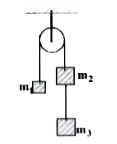Mass moves on a slope making an angle with the horizontal and is attached to mass by a string passing over a frictionless pulley as shown in the figre. The co-efficient of frition between and the slopping surfaace is . Which of the following statements are true?
 Solution in Punjabi
Solution in Punjabi
if , the boyd will move up the plane.
If (sin theta + mu cos theta), the boyd will move up the plane
If , the body will move up the plane.
If , the body will move down the plane.
Step by step video & image solution for Mass m_1moves on a slope making an angle theta with the horizontal and is attached to mass m_2 by a string passing over a frictionless pulley as shown in the figre. The co-efficient of frition between m_1 and the slopping surfaace is mu. Which of the following statements are true? by Physics experts to help you in doubts & scoring excellent marks in Class 11 exams.
Updated on:21/07/2023Topper's Solved these Questions
Similar Questions
What is the difference between gravity and gravitation?
View SolutionWhat is the unit of torr?
View SolutionTwo bodies with masses m1 and m2(m1>m2) are joined by a string passing over fixed pulley. Assume masses of the pulley and thread negligible. Then the acceleration of the centre of mass of the system (m1+m2) is
View SolutionMass m_(1) moves on a slope making an angle theta with the horizontal and is attached to mass m_(2) by a string passing over a frictionless pulley as shown in The co-efficient of friction between m_(1) and the slopping surface is mu Which of the following statements are true ? .
View SolutionIf two masses m_1 and m_2 (m_1 gt m_2) tied to string moving over a frictionless pulley, then acceleration of masses
View SolutionMass moves on a slope making an angle 9 with the horizontal and is attached to mass m2 by a string passing over a frictionless pulley . The coefficient of friction between nq and the sloping surface is μ. Which of the following statements are true ?

View SolutionThree masses m1=m,m2=2mandm3=3m are hund on a string passing over a frictionless pulley as shown in Figure . The mass of the string in negligible . The system is released from rest.

The tension in the string between masses m1andm2 is
View SolutionMass m_(1) moves on a slope making an angle theta with the horizontal and is attached to mass m_(2) by a string passing over a frictionless pulley as shown in The co-efficient of friction between m_(1) and the slopping surface is mu Which of the following statements are true ? .
View SolutionTwo unequal masses m1 and m2 are connected by a string which passes over a frictionless and massless pulley. Find the tension in the string and the acceleration of the masses.
View SolutionA massless string passes over a frictionless pulley and carries two masses m_1 and m_2(m_1 > m_2) at it's ends. If g is the acceleration due to gravity, then the thrust on the pulley is (m_1>m_2) .
View SolutionTwo bodies with masses m_1 and m_2(m_1gtm_2) are joined by a string passing over fixed pulley. Assume masses of the pulley and thread negligible. Then the acceleration of the centre of mass of the system (m_1+m_2) is
View SolutionTwo masses M1 and M2 are attached to the ends of a string which passes over a pulley attached to the top of an inclined plane Θ. The gangle of inclination of the plane is 0. Take g=10ms−2.

If M1=10kg. M2=5kg, Θ=30, the acceleration of mass M2 is
View SolutionTwo masses m1=5kg and m2=4.8kg tied to a string are hanging over a light frictionless pulley. What is the acceleration of the masses when left free to move?

View Solutionयहाँ दर्शाये गये निकाय में तीन पिण्ड m1,m2 तथा m3 एक रस्सी से जुड़े हैं जो एक घिरनी P के ऊपर होकर गुजरती है। m1 मुक्त रूप से लटका है और m2 तथा m3 एक रुक्ष क्षैतिज मेज पर हैं, जिसका घर्षण गुणांक μ है। घिरनी घर्षणरहित है और इसका द्रव्यमान नगण्य है।

यदि m1=m2=m3=m है, तो m1 का अधोमुखी (नीचे की ओर) त्वरण होगा
View SolutionThe two bodies of mass m1andm2(m1>m2) respectively are tied to the ends of a massless string, which passes. over a light and frictionless pulley. The masses are initially at rest and then released. Then acceleration of the centre of mass of the system is

View Solution
